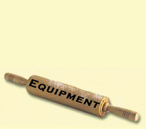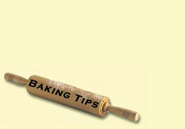|

You don't need
many special utensils in order to bake. With the simplest of tools
you'll be able to produce delicious fragrant and nutritious breads.
Basic
Equipment
A Bowl or
Pot
for mixing the dough. If you don't have a large bowl, use a stockpot
or washbasin or any vessel large enough to hold the dough during
the mixing and rising, when it will double in size. Smaller mixing
bowls are sufficient for batter-made breads.
Sturdy Wooden Spoon
Measuring Cups
Rolling Pin
the small ones you see in the supermarkets are okay but it might
be wise to invest in a sturdy one. In an emergency you can use an
empty, smooth bottle.
2 Kitchen Towels-or similar cloths to cover the dough while
it rises. You can also use a sheet of plastic wrap, which will hasten
the dough's rising because it is airtight.
Good working surface
such as a kitchen table or a counter top, large enough for comfort
when you knead the dough. The surface can be Formica or wood and
should be kept clean as should your utensils.
Cookie Sheets-several
Loaf Pans
both round and oblong. These can be bought inexpensively. Some people
prefer aluminum to glass, others like ceramic.
Muffin Tins
a couple, holding a dozen each. These are great for rolls as well
as muffins.
A Kerchief
not necessary but wise to have. It looks nice and nobody likes hairy
bread.
Flour
In Europe, you
can buy special Pastry Flour, which is a wheat flour of much softer
quality than normal. In the USA, it is grown in the Midwest, but
is hard to find in some areas. Therefore, it is recommended using
regular flour when a recipe calls for pastry flour.
Whole-Wheat Flour-contains all the different parts of the
wheat kernel, including the bran and the germ. Its appearance is
somewhat coarse and gray and makes a very nutritious and delicious
bread. Experts often use stone-ground flour because they feel that
steel-ground is affected by the intense heat of modern steel mills,
which would destroy many important nutrients.
Bran-is
part of the whole-wheat flour, but can also be bought separately.
Its cellulosic properties help aid digestion.
Rice Flour
is often used in Japan and other Eastern countries. It is said to
be lighter and better for bread baking by some. It is from ground
rice. When added to bread it sweetens the taste.
Buckwheat
is not a wheat. It comes from a plant grown in poor soil and is
closer to corn than wheat. It is used primarily for Russian and
Scandinavian breads. Add some to your dough to provide a different
taste.
Rye Flour-
comes from a different plant as well. It is a darker flour with
less gluten than wheat flours so it is recommended to mix some wheat
flour with the rye. .
Other flours
are made from Corn, Rolled Oats, Soy Beans, Peanuts, Vegetables
can be dried and ground then added to bread mixes to increase the
nutrition and give and added zip to the flavor.
Shortenings
There are many
to choose from: Butter, Margarine, Lard, Bacon Fat, Chicken Fat,
as well as various oils (Olive, Peanut, Corn etc). The use of fat
improves the keeping quality and flavor and aids in the browning.
Fat also lubricates the gluten meshwork so the dough can expand
easily.
Sweeteners
You will want
to add some kind of sweetener to the bread. A spoonful of sugar
added to the yeast sponge makes it bubble more quickly (it 'feeds'
the yeast). You can use white sugar, raw brown sugar, honey, maple
syrup, molasses, carob syrup, or fruit sugars.
Sugar helps yeast to manufacture gas bubbles and the crust to brown
during baking.
Salt
It contributes
flavor and helps to control the action of the yeast. If you use
too much, it will slow down or stop the growth of the yeast. Measure
it with care because changing the amount may harm the bread baking.
Spices
There is no limit
to the addition of spices if the taste buds want it. A particular
favorite 'spice' to add to breads in Texas is jalapenos-a very hot
pepper cut up and added to the mix to give it "bite".
You can add vegetables, cheese, and anything off the spice rack-so
long as that is what you want in your bread. Dill is especially
nice for sandwich breads. Oregano works well with Italian or Greek
breads. Use your imagination and have fun-just don't go overboard.
A novice is better off just following the recipes. Later they can
experiment but it is best to add only one spice at a time until
you know what you want and like.
Liquids
Water, milk,
and potato water are the most common liquids used. Unpasturized
milk must be scalded and cooled until lukewarm to destroy an enzyme
that makes bread gummy. Generally pasteurized milk need not be scalded.
Buttermilk does not require scalding. Water produces bread with
a crisp crust and wheaty flavor. Bread made with milk has a more
velvety grain, creamy white crumb and browner crust than that made
with water. Potato water adds a characteristic flavor and moisture
to bread: it gives a loaf a little greater volume and slightly coarser
texture.
|







